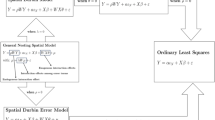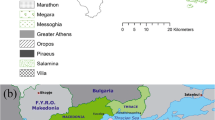Abstract
The purpose of this paper is to improve the knowledge of the Spanish urban system. We study the evolution of population growth among the group of 722 municipalities included in the Spanish urban areas over the period 1900–2001. A spatial SUR model is estimated for Zipf’s law and shows the existence of two main phases: divergence (1900–1980) and convergence (1980–2001). Then, the cross-sectional distribution of urban population is characterized by means of nonparametric estimations of density functions and the growth process is modeled as a first-order stationary Markov chain. Spatial effects are finally introduced within the Markov chain framework using regional conditioning. This analysis shows a low interclass mobility, i.e., a high-persistence of urban municipalities to stay in their own class from one decade to another over the whole period, and the influence of the geographical environment on urban population dynamism.
Similar content being viewed by others
References
Amemiya T (1985) Advanced econometrics. Harvard University Press, Cambridge
Anderson G, Ge Y (2005) The size distribution of Chinese cities. Reg Sci Urban Econ 35:756–776
Anselin L (1988) Spatial econometrics: Methods and models. Kluwer, Dordrecht
Anselin L, Le Gallo J, Jayet H (2007) Spatial panel econometrics. In: Matyas L, Sevestre P (eds) The econometrics of panel data, 3rd edn. Kluwer, Dordrecht
Bickenbach F, Bode E (2003) Evaluating the Markov property in studies of economic convergence. Int Reg Sci Rev 26:363–392
Black D, Henderson V (1999) Spatial evolution of population and industry in the United States (AEA Papers and Proceedings). Am Econ Rev 89:321–327
Black D, Henderson V (2003) Urban evolution in the USA. J Econ Geogr 3:343–372
Blakman S, Garretsen H, Van Marrewijk C, Van den Berg M (1999) The return of Zipf: towards a further understanding of the rank-size distribution. J Reg Sci 39:183–213
Bulli S (2001) Distribution dynamics and cross-country convergence: a new approach. Scott J Polit Econ 48:226–243
Cheshire P, Magrini S (2000) Endogenous processes in European regional growth: convergence and policy. Growth Change 31:455–479
Cordoba JC (2003) On the distribution of city sizes. Mimeo, Economics Department, Rice University
Davis D, Weinstein D (2002) Bones, bombs, and break points: the geography of economic activity. Am Econ Rev 92:1269–89
Dobkins L, Ioannides YM (2000) Dynamic evolution of the US city size distribution. In: Huriot JM, Thisse JF (eds) Economics of cities. Cambridge University Press, Cambridge, pp 217–260
Duranton G (2006) Some foundations for Zipf’s law: product proliferation and local spillovers. Reg Sci Urban Econ 36:542–563
Eaton J, Eckstein Z (1997) City and growth: theory and evidence from France and Japan. Reg Sci Urban Econ 17:443–474
Esteve A, Devolder D (2004) De la ley rango-tamaño (ranz-size) a la ley log-normal: los procesos aleatorios en el crecimiento demográfico de los agregados de población. VII Congreso de la Asociación de Demografía Histórica, Granada
Fielding AJ (1989) Migration and urbanization in Western Europe since 1950. Geogr J 155:60–69
Fingleton B (1983a) Independence, stationarity, categorical spatial data and the chi-squared test. Environ Plann A15:483–499
Fingleton B (1983b) Log-linear models with dependent spatial data. Environ Plann A15:801–814
Fingleton B (1986) Analyzing cross-classified data with inherent spatial dependence. Geogr Anal 18:48–61
Fingleton B (1999) Estimates of time to economic convergence: an analysis of regions of the European Union. Int Reg Sci Rev 22:5–34
Fingleton B (2001) Theoretical economic geography and spatial econometrics: dynamic perspectives. J Econ Geogr 1:201–225
Fingleton B, Lopez-Bazo E (2003) Explaining the distribution of manufacturing productivity in the EU regions. In: Fingleton B (ed) European regional growth. Springer, Heidelberg, pp 375–409
Fusi JP, Vilar S, Preston P (1983) De la dictadura a la democracia. Desarrollismo, crisis y transición. Historia 16, vol. XXV
Gabaix X (1999a) Zipf’s law and the growth of cities (AEA Papers and Proceedings). Am Econ Rev 89:129–132
Gabaix X (1999b) Zipf’s law for cities: an explanation. Quar J Econ 114:759–767
Gabaix X, Ibragimov R (2006) Rank − 1/2: a simple way to improve the OLS estimation of tail exponents. Available for download at: http://econ-www.mit.edu/faculty/index.htm?prof_id=xgabaix&type=paper
Gabaix X, Ioannides YM (2004) The evolution of city size distributions. In: Henderson V, Thisse JF (eds) Handbook of regional and urban economics, vol 4. North Holland, Amsterdam, pp 2341–2378
Grossman G, Helpman E (1991) Innovation and growth in the world economy. MIT Press, Cambridge
Hamilton JD (1994) Time series analysis. Princeton University Press, Princeton
Hordijk L, Nijkamp P (1977) Dynamic models of spatial autocorrelation. Environ Plann A9:505–519
Ioannides YM, Overman HG (2003) Zipf’s law for cities: an empirical examination. Reg Sci Urban Econ 33:127– 137
Johnson PA (2002) A nonparametric analysis of income convergence across the United States. Econ Lett 69:219–223
Kawagoe M (1999) Regional dynamics in Japan: a reexamination of Barro regressions. J Jpn Int Econ 13:61–72
Kemeny J, Snell L (1976) Finite Markov chains. Springer, New York
Krugman P (1996) The Self-organizing economy. Blackwell, Cambridge
Lanaspa L, Perdiguero AM, Sanz F (2004) La distribución del tamaño de las ciudades en España, 1900–1999. Revista de Economía Aplicada 34:5–16
Lanaspa L, Pueyo F, Sanz F (2003) The evolution of Spanish urban structure during the twentieth century. Urban Stud 40:567–580
Le Gallo J (2004) Space-time analysis of GDP disparities among European regions: a Markov Chains approach. Int Reg Sci Rev 27:138–163
Lopez-Bazo E, Vaya E, Mora AJ, Suriñach J (1999) Regional economic dynamics and convergence in the European Union. Ann Reg Sci 33:343–370
Magrini S (1999) The evolution of income disparities among the regions of the European Union. Reg Sci Urban Econ 29:257–281
Mella JM, Chasco C (2006) A spatial econometric analysis of urban growth and territorial dynamics: a case study on Spain. In: Nijkamp P, Reggiani A (eds) Spatial evolution and modeling. Edward Elgar, pp 319–360
Ministerio de Fomento (2000) Atlas Estadístico de las Áreas Urbanas en España, Subdirección General de Urbanismo, Madrid
Monclús FJ (1997) Planeamiento y crecimiento suburbano en Barcelona: de las extensiones periféricas a la dispersión metropolitana (1897–1997). Coloquio sobre El desarrollo urbano de Montréal y Barcelona en la época contemporánea: estudio comparativo, Universidad de Barcelona
Nitsch V (2005) Zipf zipped. J Urban Econ 57:86–100
Overman HG, Ioannides YM (2001) Cross-sectional evolution of the US city size distribution. J Urban Econ 49:543– 566
Pareto V (1897) Cours d’Economie Politique. Rouge et Cie, Paris
Quah D (1993) Empirical cross-section dynamics in economic growth. Euro Econ Rev 37:426–434
Quah D (1996) Empirics for economic growth and convergence. Euro Econ Rev 40:1353–1375
Quah D (1997) Empirics for growth and distribution: stratification, polarization, and convergence clubs. J Econ Growth 2:27–59
Rey S (2001) Spatial empirics for economic growth and convergence. Geogr Anal 33:195–214
Rossi-Hansberg E, Wright M (2004) Urban structure and growth. Mimeo, Stanford University, Economics Department
Soo KT (2005) Zipf’s law for cities: a cross-country investigation. J Urban Econ 35:239–263
Stanback T. Jr (1991) The new suburbanisation: challenge to the central city. Westwiew Press, Boulder
Tan B, Yilmaz K (2002) Markov chain test for time dependence and homogeneity: an analytical and empirical evaluation. Euro J Oper Res 137:524–543
Tuñón de Lara M, Malerbe PC (1982) La caída del rey. De la quiebra de la Restauración a la República (1917–36). Historia 16, vol. XXIII
Tuñón de Lara M, Viñas A (1982) La España de la cruzada. Guerra civil y primer franquismo (1936–1959). Historia 16, vol. XXIV
Tuñón de Lara M, Bahamonde A, Toro, J, Arostegui J (1982) La España de los caciques. Del sexenio democrático a la crisis de 1917. Historia 16, vol. XXII
White E, Hewings GJD (1982) Space-time employment modelling: some results using seemingly unrelated regression estimators. J Reg Sci 22:283–302
Zellner A (1962) An efficient method of estimating seemingly unrelated regressions and tests for aggregation bias. J Am Stat Assoc 57:348–368
Zipf GK (1949) Human behavior and the principle of least effort. Addison-Wesley, Cambridge
Author information
Authors and Affiliations
Corresponding author
Additional information
Previous versions of this paper were presented at the 45th Congress of the European Regional Science Association (Vrije Universiteit, Amsterdam, Netherlands, August 23–27, 2005) and at the International Workshop on Spatial Econometrics and Statistics (Rome, Italy, May 25–27, 2006). We would like to thank two anonymous referees, M. Bosker, P. Cheshire, A. Carrington, B. Fingleton, R. Guillain, E. Lopez-Bazo, J. Paelinck and the other participants of these meetings for their valuable comments. Coro Chasco acknowledges financial support from the Spanish Ministry of Education and Science SEJ2006-14277-C04-01. The usual disclaimers apply.
Rights and permissions
About this article
Cite this article
Le Gallo, J., Chasco, C. Spatial analysis of urban growth in Spain, 1900–2001. Empirical Economics 34, 59–80 (2008). https://doi.org/10.1007/s00181-007-0150-5
Received:
Accepted:
Published:
Issue Date:
DOI: https://doi.org/10.1007/s00181-007-0150-5




